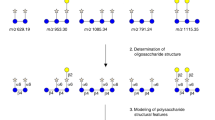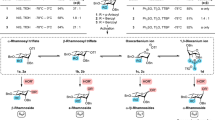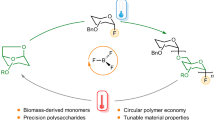Abstract
STRUCTURAL studies of polysaccharides containing uronic acid residues involve the identification of the uronic acid and the determination of the manner in which it is joined to other sugar residues in the polysaccharide1,2. The identification of the uronic acid usually presents little difficulty if the modified methods of hydrolysis3,4, coupled with chromatographic analysis5,6, are applied. The nature of the linkage between the uronic acid residue and the other sugar components has been ascertained by periodate oxidation7 and by methylation studies. The former method is of limited application whereas the latter, which involves the identification of a methyl derivative of the uronic acid, has been widely employed2,8,9,10. The identification can be time-consuming when reference substances are not available, and occasionally it presents difficulty inasmuch as removal of the glycosidic methyl group, which often forms part of the identification procedure, is accompanied by decarboxylation and decomposition.
This is a preview of subscription content, access via your institution
Access options
Subscribe to this journal
Receive 51 print issues and online access
$199.00 per year
only $3.90 per issue
Buy this article
- Purchase on Springer Link
- Instant access to full article PDF
Prices may be subject to local taxes which are calculated during checkout
Similar content being viewed by others
References
Hirst, J. Chem. Soc., 70 (1942).
Jones and Smith, “Advances in Carbohydrate Chemistry”, 4, 243 (Academic Press, Inc., New York, 1949).
Spoehr, Arch. Biochem., 14, 153 (1947).
Frush and Isbell, J. Res., Nat. Bur. Stand., 37, 321 (1946).
Partridge and Westhall, Biochem. J., 42, 238 (1948).
Flood, Hirst and Jones, J. Chem. Soc., 1679 (1948).
Lucas and Stewart, J. Amer. Chem. Soc., 62, 1792 (1940).
Challinor, Haworth and Hirst, J. Chem. Soc., 258 (1931).
Hough and Jones, J. Chem. Soc., 1199 (1950).
White, J. Amer. Chem. Soc., 70, 367 (1948).
Levene, Tipson and Kreider, J. Biol. Chem., 122, 199 (1937).
Levene and Christman, J. Biol. Chem., 122, 203 (1937).
Cf. Levene and Kreider, J. Biol. Chem., 121, 155 (1937).
Nystrom and Brown, J. Amer. Chem. Soc., 69, 1197 (1947).
Nystrom and Brown, J. Amer. Chem. Soc., 69, 2548 (1947).
Finholt, Bond and Schlesinger, J. Amer. Chem. Soc., 69, 1199 (1947).
Smith (to be published).
Luckett and Smith, J. Chem. Soc., 1106 (1940).
Smith, J. Chem. Soc., 1724 (1939).
Author information
Authors and Affiliations
Rights and permissions
About this article
Cite this article
ABDEL-AKHER, M., SMITH, F. Use of Lithium Aluminium Hydride in the Study of Carbohydrates. Nature 166, 1037–1038 (1950). https://doi.org/10.1038/1661037a0
Issue Date:
DOI: https://doi.org/10.1038/1661037a0
This article is cited by
-
Some generalizations relative to lithium aluminum hydride reactions
Experientia (1954)
Comments
By submitting a comment you agree to abide by our Terms and Community Guidelines. If you find something abusive or that does not comply with our terms or guidelines please flag it as inappropriate.



